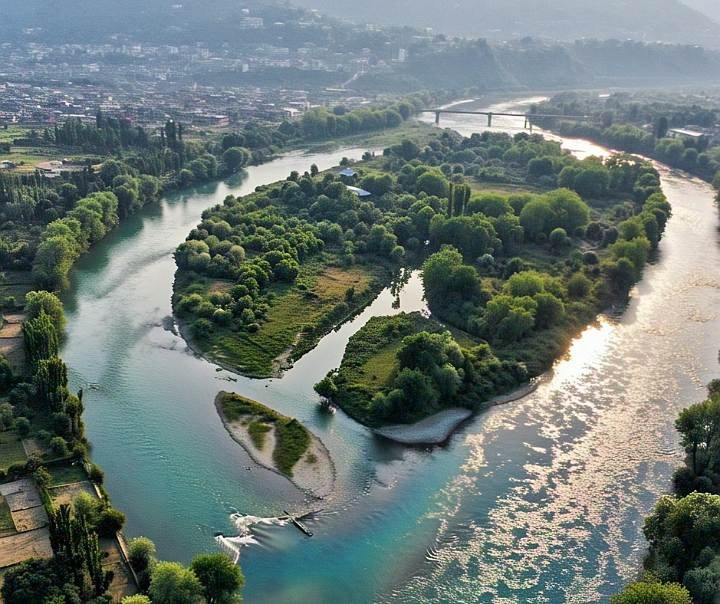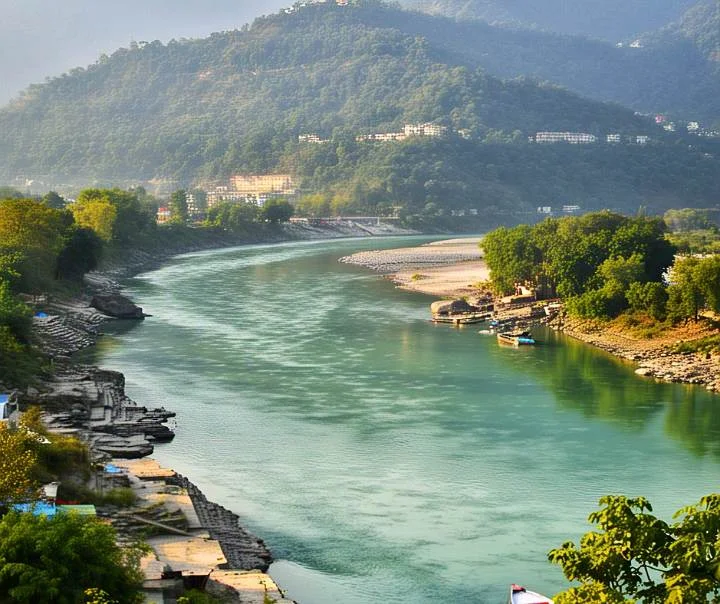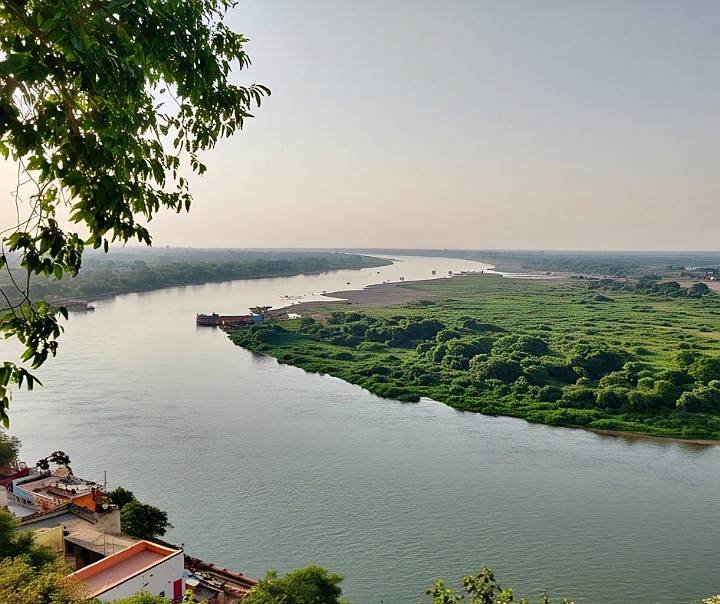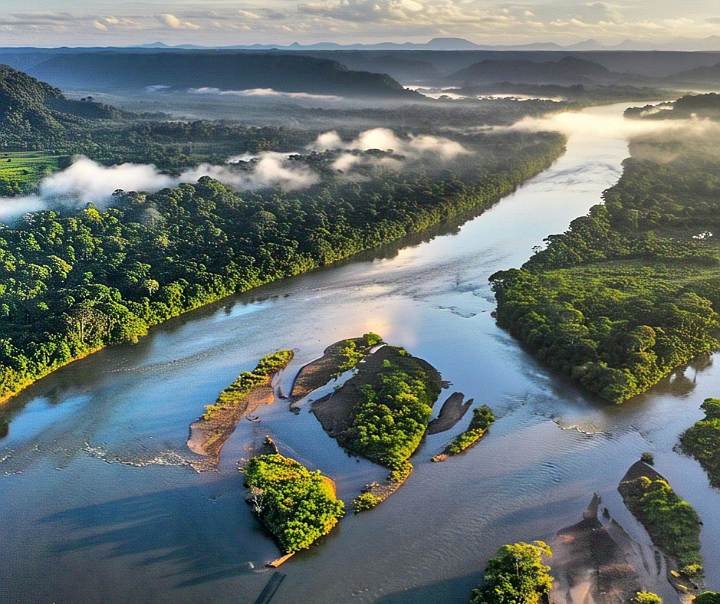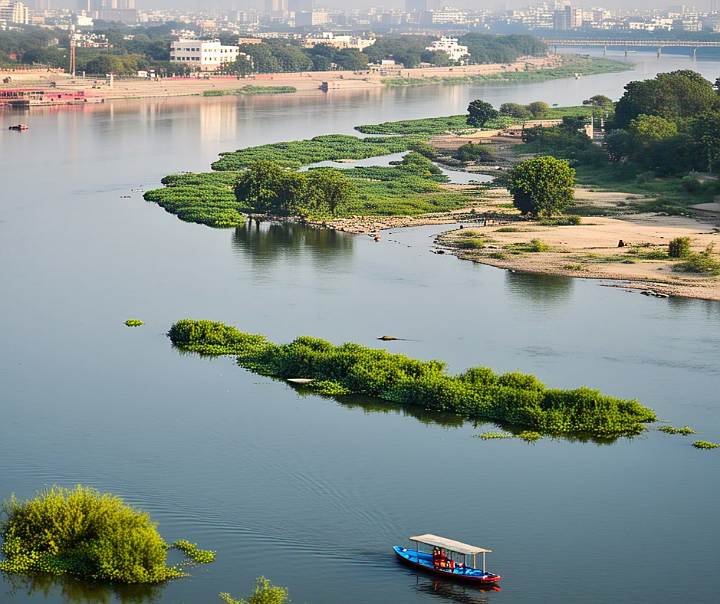Narmada River : Origin, History, Importance, and Interesting Facts
Friends, imagine a river that flows from east to west, carving through mountains on its way to the sea, and isn’t just water but a symbol of faith, history, and life itself. Yes, I’m talking about the Narmada River.
If I were explaining this in a college classroom, I’d probably sketch a map on the board and say, “Look, this is India’s unique stream—it’s been a border between north and south, a source of disputes, but always a resident in people’s hearts.” Today in this blog, we’ll explore the Narmada up close—from its source to its mouth, its mysteries to its challenges. Let’s embark on this journey, like flipping through the pages of an old book.
Narmada River Infobox
Category | Information |
|---|---|
Origin (Source) | Amarkantak Plateau (Anuppur District, Madhya Pradesh) |
End (Mouth) | Gulf of Khambhat (Arabian Sea), near Bharuch, Gujarat |
Length | Approximately 1,312 km (815 miles) |
Major States Flowing Through | Madhya Pradesh (Largest section), Maharashtra, and Gujarat |
Direction of Flow | West ⬅️ (It is one of only a few major rivers in India that flows west) |
Key Geographical Feature | Flows through a Rift Valley (a depression between the Vindhya and Satpura ranges). |
Major Tributaries | Tawa, Hiran, Kolar, Orsang |
Significance | Considered one of the seven holy rivers (Sapta Sindhu) of India – deeply revered in Hindu mythology. |
Major Project/Dam | Sardar Sarovar Dam (Gujarat) |
Other Names | Reva |
The Origin of the Narmada River
First, let’s talk about the Narmada’s birth. The Narmada originates in Madhya Pradesh’s Anuppur district, on the Amarkantak Plateau, right from a small reservoir called Narmada Kund. At an elevation of about 1,048 meters, the river emerges and soon tumbles down from Sonmuda to form the Kapildhara waterfall. I’ve visited Amarkantak once—it’s so serene that it feels like time has stopped. From there, the river winds through hills, over rocks, and reaches the ruins of Ramnagar.
If you want more details, you can read the full history of the Narmada on Wikipedia—everything from small facts to big ones is there. This river is 1,312 kilometers long, making it India’s fifth longest and the longest west-flowing river in Peninsular India. Its course starts in Madhya Pradesh, brushes Maharashtra’s border, enters Gujarat, and finally meets the Gulf of Khambhat (Arabian Sea) in Bharuch district.
Along the way, it passes through a rift valley between the Vindhya and Satpura mountain ranges, which has traditionally been the boundary between North and South India. Near Jabalpur, the Dhuandhar waterfall and the marble rocks of Bhedaghat—these are all gifts from the Narmada’s path.
Tributaries and Basin
Now think about it—the Narmada doesn’t flow alone; it has 41 tributaries! From the left bank come 22 rivers from the Satpura range, like Tawa (the largest), Burhner, Banjar, and Sher. From the right bank, rivers from the Vindhya range, such as Hiran, Barna, and Kolar. All these together form a basin spanning 98,796 square kilometers—which is about 3% of India’s total area. It covers 82% in Madhya Pradesh, 12% in Gujarat, 4% in Maharashtra, and 2% in Chhattisgarh.

This basin is divided into five geographical zones—from upper hilly areas to lower plains. The soil is black, forests cover 35%, and 60% of the land is fertile for agriculture. In the upper reaches, rainfall is 1,000-1,850 mm, while in the lower parts, it’s 650-750 mm. If you’re into climate and geography, check out the detailed hydrology of the Narmada on Britannica—it’s always reliable for facts.
Cultural and Religious Significance
Friends, the Narmada isn’t just a stream of water—it’s a goddess. In Hinduism, it’s considered the second holiest river after the Ganga. The Matsya Purana says both its banks are sacred. It’s called the Mukti Dayini Ma, and the Puranas say: “Ganga for bathing, Yamuna for drinking, Narmada for darshan, Tapi for remembrance.” Just seeing the Narmada grants moksha!
Read more – Godavari River :Origin, Tributaries and Interesting Information
In myths, Narmada is Shiva’s daughter—according to the Reva Khand, she was born from Shiva’s sweat during his penance. Another tale says she and the Son River emerged from Brahma’s two tears, and their engagement was fixed with Sonbhadra. Adi Shankaracharya met his guru Govind Bhagwatpada here at Omkareshwar. It’s the only river in the world with a parikrama— the 2,600 km Narmada Parikrama from Bharuch to Amarkantak, which takes three years without crossing the river. In Gujarat, lakhs of devotees come for the Uttarvahini Panchkoshi Parikrama.
Culturally, the Narmada’s pebbles (white quartz stones) are considered Shivlings—”Narmada ke kankar utte Shankar.” If you’re interested in religious tourism, take a look at Madhya Pradesh Tourism’s site for Amarkantak and Omkareshwar—you’ll find photos and tips there.
Historical Significance and Mysteries
The Narmada’s history goes back millions of years. Geologically, it’s a rift valley formed 160 million years ago when Pangea broke apart. Dinosaur fossils have been found here—the first one in Jabalpur in 1828, and a species named Rajasaurus narmadensis is linked to the Narmada Valley. In 1982, a Homo erectus skull (the Narmada Man) was discovered in Hathnora village, the oldest hominin in South-East Asia.
During British times, it was called Narbada, and in ancient texts, Reva. This river served as a trade route between the Ganga Valley and the Arabian Sea. For more, click on this Times of India story—it explains why the Narmada remained “unmarried.”
Economic Importance
The Narmada is the backbone of development today. Its annual water flow is 33 million acre-feet. The biggest project is the Sardar Sarovar Dam in Gujarat—the world’s second-largest concrete dam, generating 1,450 MW of power. The Indira Sagar Dam in Madhya Pradesh provides 1,000 MW. The Narmada Canal is 532 km long, irrigating dry areas in Gujarat and Rajasthan. But this has been a subject of inter-state disputes since the 1960s—the Narmada Water Disputes Tribunal gave its verdict in 1978.
Check the latest updates on projects at the Narmada Control Authority’s official site—it’s a government source, totally trustworthy.
Environmental Challenges
But friends, this shine of development doesn’t come without shadows. Dams like Sardar Sarovar displaced lakhs of people and submerged forests. Since 1985, the Narmada Bachao Andolan (led by Medha Patkar and Baba Amte) raised its voice—the World Bank stopped funding in 1993. The Supreme Court allowed completion in 2000, but with rehabilitation conditions. Even today, biodiversity is at risk—Tigers, leopards, hornbills—their home is in Satpura and Kanha National Parks in the Narmada basin.
For the environment, read Earth5R’s report—it focuses on the Narmada’s ecological importance.
Biodiversity and Tourism
The Narmada Valley is full of dry deciduous forests—teak, sal, mahua. There are 76 mammal species, 276 birds. Protected areas like Kanha (home of The Jungle Book), Satpura National Park.
For tourism, Amarkantak, Omkareshwar, Maheshwar, Bhedaghat—these are must-visits. The Statue of Unity near Sardar Sarovar is the world’s tallest statue. DIY.org has fun Narmada facts for kids—great if you’re planning a family trip.
FAQ – Narmada River
Q1: Where does the Narmada River originate?
A: The Narmada River originates from the Amarkantak Plateau in Madhya Pradesh, India.
Q2: How long is the Narmada River?
A: The Narmada River is approximately 1,312 kilometers long, making it the longest west-flowing river in India.
Q3: Which states does the Narmada River flow through?
A: It flows through Madhya Pradesh, Maharashtra, and Gujarat before emptying into the Arabian Sea.
Q4: What are the major tributaries of the Narmada River?
A: Major tributaries include Tawa, Burhner, Banjar, Sher, Hiran, Barna, and Kolar.
Q5: Why is the Narmada River considered sacred?
A: In Hinduism, the Narmada is regarded as the daughter of Lord Shiva, and its waters are believed to grant spiritual liberation.
Q6: What are the famous dams on the Narmada River?
A: Sardar Sarovar Dam (Gujarat) and Indira Sagar Dam (Madhya Pradesh) are the major dams built on the river.
Q7: What is Narmada Parikrama?
A: Narmada Parikrama is a 2,600 km pilgrimage circuit along the river from Bharuch to Amarkantak, traditionally completed on foot.
Q8: What is the ecological significance of the Narmada River?
A: The river supports biodiversity including tigers, leopards, hornbills, and sustains forests and agriculture in its basin.
Q9: What is the historical importance of the Narmada River?
A: It has been a trade route since ancient times and is geologically significant as a rift valley formed millions of years ago.
Q10: Why is the Narmada River important for India’s economy?
A: The river provides water for irrigation, hydroelectric power, and supports industries along its basin.
Read more – Yamuna River : Complete information from its origin to its merging
The Message of the Narmada River
So friends, the Narmada River isn’t just a geographical wonder—it’s the heartbeat of our civilization. It teaches us how to balance development and conservation. Next time you’re standing on its banks, remember—this stream has been flowing for centuries, and we’re all part of it. If you liked this post, share your Narmada story in the comments. Let’s pledge to save it!
